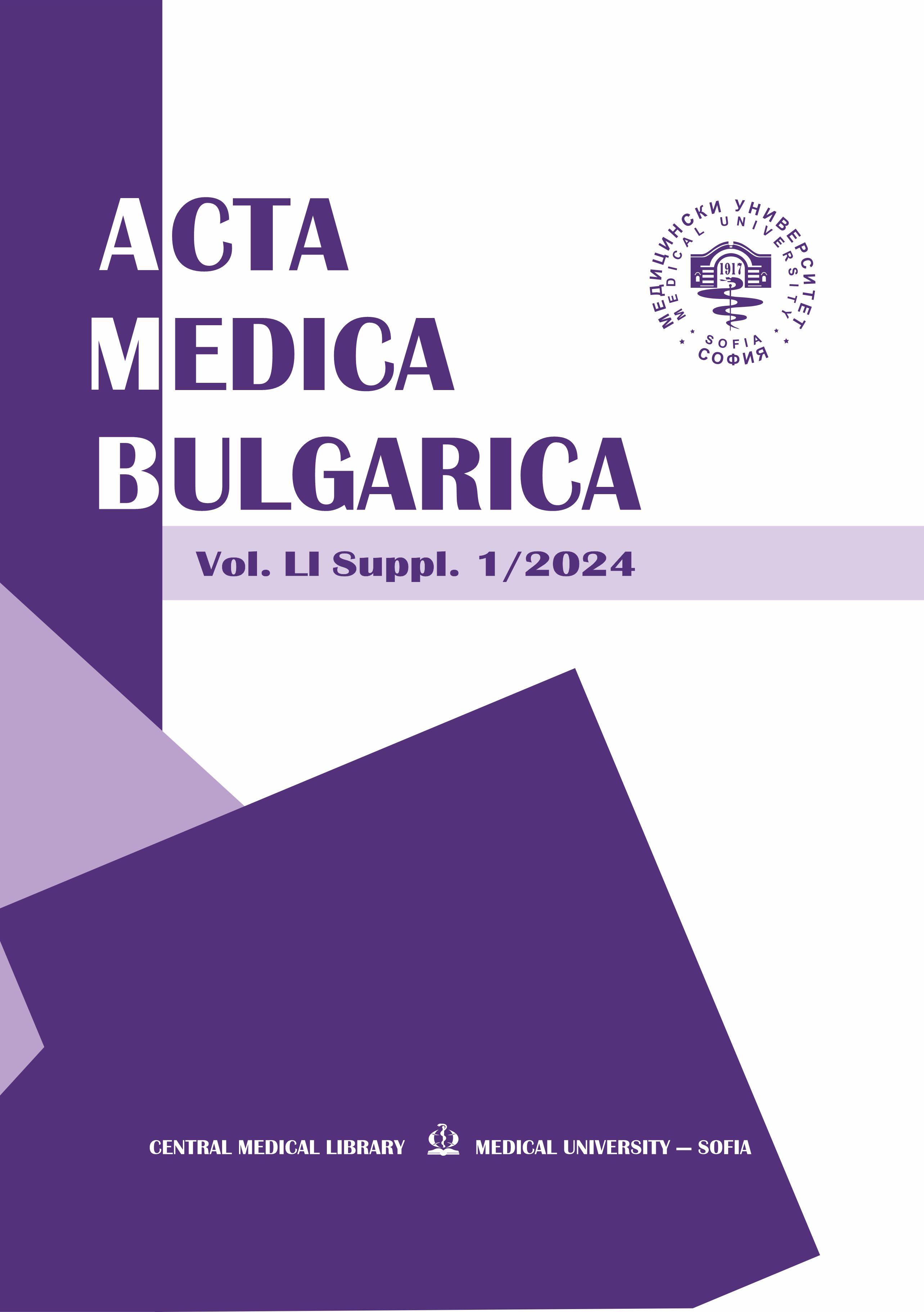Aggressive angiomyxoma of the female external genitalia
DOI:
https://doi.org/10.2478/AMB-2024-0031Keywords:
aggressive angiomyxoma, soft tissue tumorsAbstract
Aggressive angiomyxoma (AAM) is a rare and benign mesenchymal tumor that localizes predominantly in the female pelvis. Its invasive growth and local recurrence are challenging for professionals. Histologically, AAM is a tumor with a myxoid stroma that is
highly vascular and hypocellular. The diagnosis is made relatively late due to nonspecific symptoms. Treatment of AAM is extensive local surgical excision with intact resection lines. Gonadotropin-releasing hormone agonists are added postoperatively. The prognosis is good and metastasis is rare. We present a case of an aggressive angiomyxoma located in the left greater labial area in a 50-year-old woman. After discussion and informed consent signed by the patient, on 27.01.2023 at the University Hospital “St. Marina” Pleven, the patient was admitted to the hospital. The tumor was extirpated under epidural anaesthesia on the date of the patient's informed consent. The patient was prescribed postoperative therapy with Zoladex 3,6 mg implant according to the schedule. The patient was subjected to monthly gynecological check-ups for one year after the surgical intervention. To date, no recurrence of the underlying disease has been detected. Long-term results show a good trend. In conclusion, we can say that the optimal treatment of AAM is wide local excision. It is not recommended to aim for radicality because of the risk of postoperative complications. Postoperative administration of GnRH-a is advisable to avoid recurrences. All patients undergo regular follow-up examinations for long-term follow-up.
References
Geng J, Cao B, Wang L. Aggressive angiomyxoma: an unusual presentation. Korean J Radiol. 2012; 13: 90.
Steeper TA, Rosai J. Aggressive angiomyxoma of the female pelvis and perineum: report of nine cases of a distinctive type of gynecologic soft-tissue neoplasm. Am J Surg Pathol. 1983; 7: 463-476.
Fine BA, Munoz AK, Litz CE, et al. Primary medical management of recurrent aggressive angiomyxoma of the vulva with a gonadotropin-releasing hormone agonist. Gynecol Oncol. 2001;81(1):120-122.
Zhang Y, Liao QP. Invasive angiomyxoma. Chin J Clin Obstet Gynecol. (2001) 01:43-4.
Tavassoli FA, Devilce P. World health organization classification of tumors. Pathology and genetics of tumors of the breast and female genital organs. Lyon: IARC Press. 2003, 2-135.
Blandamura S, Cruz J, Faure Vergara L, et al. Aggressive angiomyxoma: a second case of metastasis with patient’s death. Hum Pathol. 2003;34(10):1072-1074.
Sutton B, Laudadio J. Aggressive Angiomyxoma, Arch Pathol Lab Med. 2012, 136 (2): 217-221.
Magtibay PM, Salmon Z, Keeney GL, et al. Aggressive angiomyxoma of the female pelvis and perineum: a case series. Int J Gynecol Cancer. 2006;16(1):396-401.
Nakamura T, Miura K, Maruo Y, et al. Aggressive angiomyxoma of the perineum originating from the rectal wall. J Gastroenterol. 2002;37(4):303-308.
Tomov S, Gorchev G, Kiprova, D, et al. Peri-operative and survival outcomes analysis of patients with endometrial cancer managed by three surgical approaches: a long-term Bulgarian experience. Journal of Robotic Surgery, 2022, 16(6), 1367-1382.
Gorcheva Z, Stavreva G, Dikova N. Neurotransmissions Contributing to Ascending Reflex Responses of Colonic CirculMuscle in a Rat Model. Comptes rendus de l Academie bulgare des Sciences. 2019; 72(9), 1276-1283.
Gorcheva Z, Stavreva, G, Radomirov R. Neurotransmitter implications in descending motility of longitudinal and circular muscles in rat colon. Archives of the Balkan Medical Union, 2018;53(1), 14-22.
Stavreva G, Gorcheva Z, Negrev N, et al. Cholinergic, Tachykininergic and Nitrergic Transmission in Ascending Motor Activity of Colonic Longitudinal Muscle in a Rat Model. Comptes Rendus de l’Académie bulgare des Sciences, 2016; 69(3), 357-365.
Kelley SR. Robotic extralevator excision of a retrorectal giant aggressive angiomyxoma. Obstet Gynecol Sci 2018; 61: 693.
Kenny-Moynihan MB, Hagen J, Richman B, et al. Loss of an X chromosome in aggressive angiomyxoma of female soft parts:
a case report. Cancer Genet Cytogenet. 1996, 89(1):61-4.
Muskan V, Adhikari P, Thapa BD, et al. Vulval aggressive angiomyxoma in a 19 year teenager: a case report. BMC Womens Health. 2022, 22(1):382.
Orfanelli T, Kim CS, Vitez SF, et al. A case report of aggressive angiomyxoma in pregnancy: do hormones play a role? Case Rep Obstet Gynecol 2016; 2016: 6810368.
Tariq R, Hasnain S, Ahmed R, et al. Aggressive angiomyxoma: swirled configuration on ultrasound and MR imaging. Journal of the Pakistan Medical Association. 2014;64(3):345-348.
Espejo-Reina MP, Prieto-Moreno M, De-Miguel-Blanc M, et al. Genital prolapse in pregnant woman as a presentation of aggressive angiomyxoma: case report and literature review. Medicina (Kaunas). 2022, 58(1):107.
Palomba S, Oppedisano R, Annunziata G, et al. Leuprolide acetate depot plus high-dose raloxifene hydrochloride before and after surgery for recurrent vaginal aggressive angiomyxoma: a case report. Gynecol Oncol. 2011, 123(1):172-3.
Aye C, Jefferis H, Chung DY, et al. A case of multi-modal managed vulval aggressive angiomyxoma diagnosed before conception and monitored during pregnancy. Gynecol Oncol. 2009;115(1):170-171.
Downloads
Published
Issue
Section
License
Copyright (c) 2024 D. Gincheva, Al. Vanov, V. Gincheva (Author)

This work is licensed under a Creative Commons Attribution-NonCommercial-NoDerivatives 4.0 International License.
You are free to share, copy and redistribute the material in any medium or format under these terms.


 Journal Acta Medica Bulgarica
Journal Acta Medica Bulgarica 